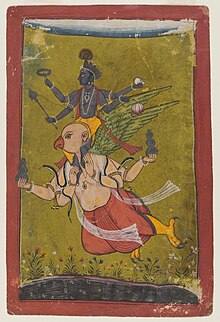bio.wikisort.org - Plant
The Vaijayanti (Sanskrit: वैजयन्ति, romanized: Vaijayantī, lit. 'garland of victory')[1] is a mythological garland or elemental necklace, primarily associated with Vishnu.[2] Employed in its worship as a garland, this object is also called the Vaijayantimala, or the Vanamala.[3][4]
| Vaijayanti | |
|---|---|
 Vishnu wears the garland, seated upon Garuda | |
| Venerated in | Vaishnavism |
| Texts | Vishnu Purana |
In Sri Vaishnava tradition, the poet-saint Thondaradippodi Alvar is regarded to be a manifestation of the Vanamala.[5]

Literature
Vaijayanti finds a mention in Vishnu Sahasranama, a stotram dedicated to Vishnu in the Mahabharata, as vanamali (forest flowers).[6]
The garland of victory is mentioned in the Mahabharata, as made of never-wilting lotuses.
| Part of a series on |
| Vaishnavism |
|---|
 |
In the Skanda Purana, Varuna presents Lakshmi with the garland as a wedding gift.[7]
According to the Vishnu Purana, the garland prominently displays five precious gemstones: emerald, sapphire, ruby, pearl, and diamond. These correspond with the five classic elements commonly named earth, water, fire, air, and ether respectively.[6][8]
In the Shiva Purana, Vishnu offers his garland to his son-in-law Kartikeya, before his battle with the asura Taraka.[9]
The Garuda Purana includes a prayer known as the Vishnu Panjaram, which includes the following verse: "Taking up Vaijayanti and Srivatsa, the ornament of thy throat do thou protect me in the north-west, O god, O Hayagriva. I bow unto thee".[10]
See also
- Padma
- Kaustubha
- Shaligrama
References
- D Dennis Hudson (27 August 2008). The Body of God Emperor's Palace for Krishna in Eighth-Century Kanchipuram: An Emperor's Palace for Krishna in Eighth-Century Kanchipuram. Oxford University Press. pp. 168–. ISBN 978-0-19-970902-1.
- www.wisdomlib.org (25 April 2016). "Vaijayanti, Vaijayantī, Vaijayamti: 19 definitions". www.wisdomlib.org. Retrieved 3 August 2022.
- Prof. Shrikant Prasoon (17 February 2014). Hinduism Clarified and Simplified. V&S Publishers. pp. 235–. ISBN 978-93-81384-72-5.
- Rūpagosvāmī (2003). The Bhaktirasāmṛtasindhu of Rūpa Gosvāmin. Motilal Banarsidass. pp. 575–. ISBN 978-81-208-1861-3.
- Dalal, Roshen (18 April 2014). Hinduism: An Alphabetical Guide. Penguin UK. p. 160. ISBN 978-81-8475-277-9.
- V. Ravi (30 November 2012). Vishnu Sahasranama. MANBLUNDER. p. 248. GGKEY:DRA5CW5BDZX.
- www.wisdomlib.org (5 March 2020). "The Marriage Festival of Lakṣmī and Nārāyaṇa [Chapter 14]". www.wisdomlib.org. Retrieved 3 August 2022.
- www.wisdomlib.org (30 August 2014). "Dominion over different provinces of creation assigned to different beings [Chapter XXII]". www.wisdomlib.org. Retrieved 3 August 2022.
- www.wisdomlib.org (14 October 2018). "Kārttikeya is crowned [Chapter 5]". www.wisdomlib.org. Retrieved 3 August 2022.
- www.wisdomlib.org (12 April 2015). "The prayer of Vishnu Panjaram [Chapter XIII]". www.wisdomlib.org. Retrieved 3 August 2022.
Другой контент может иметь иную лицензию. Перед использованием материалов сайта WikiSort.org внимательно изучите правила лицензирования конкретных элементов наполнения сайта.
WikiSort.org - проект по пересортировке и дополнению контента Википедии
